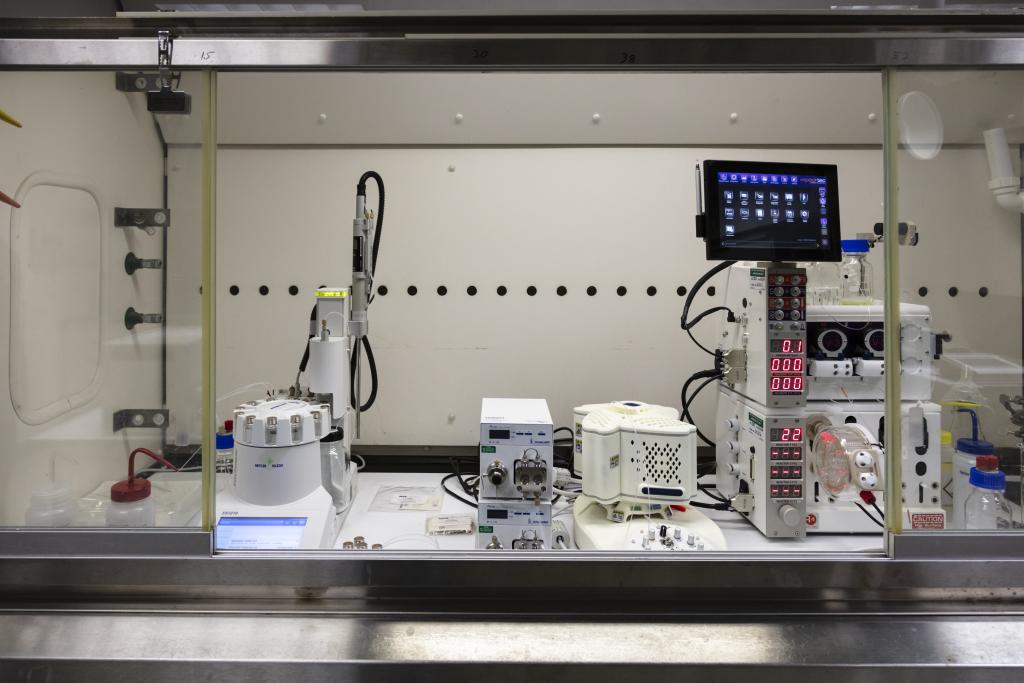INTERSECT’s Autonomous Chemistry Lab for Accelerated Materials Discovery and Innovation is home to robots capable of completing routine tasks. Credit: Carlos Jones/ORNL, U.S. Dept. of Energy
Following a series of demonstrations, the Interconnected Science Ecosystem initiative, or INTERSECT, at the Department of Energy’s Oak Ridge National Laboratory exhibited the progress of its various projects during a hybrid event open to all of ORNL late last year.
Established in 2022, INTERSECT aims to launch the smart labs of the future – a set of interconnected research spaces equipped with robots and other autonomous instruments programmed and overseen by scientists.
Connecting these resources to ORNL’s supercomputers and integrating AI and ML capabilities could streamline every part of an experiment – from handling delicate samples to analyzing complex data. Such advances would accelerate time to solution and by extension scientific breakthroughs.
This demo marks the first time that scientists outside the INTERSECT team have seen the new tools that they might eventually incorporate into their research workflows. About 50 people from across ORNL, including experts in neutron scattering, materials science and computing, attended some portion of the demo either online or in person.
“We’re building the core infrastructure and abstraction layers that others can use and build upon,” said Ben Mintz, director of INTERSECT. “We’ve already tied INTERSECT to several science use cases, so the next step is to make additional improvements to the infrastructure, build new capabilities and continue sharing it with scientists to make their lives easier.”
During the demo, representatives from three of INTERSECT’s scientific projects presented videos to walk attendees through the contents of their labs.
The autonomous chemistry lab showcased two robots — one that moves samples from place to place during routine materials synthesis experiments and another that develops catalysts for chemical reactions. The robots currently work independently, but the project team plans to facilitate collaboration between them to maximize efficiency.
“Robots don’t have to sleep, so they can work on monotonous and time-consuming tasks 24/7,” Mintz said. “This frees up researchers to devote more time for analyzing data, formulating new hypotheses and performing more complex tasks to solve scientific problems.”

INTERSECT’s Autonomous Continuous Flow Reactor Synthesis for Atom-Precision with Scalability project, or AutoFlowS, uses a novel framework to characterize materials and produce desired products through chemical reactions. The AutoFlowS team explained how multiple setups in their lab enable faster results without sacrificing accuracy.
“With scientists in the loop, it would take 2 to 3 days to complete some of these chemical reactions, but the AutoFlowS reactor can do so in a couple of minutes, and that saves a lot of time and effort,” Mintz said.
An automated microscopy project also had a chance to shine. In their video, team members illustrated next-generation electron microscopes autonomously scanning the surface of a sample to quickly identify any unique features that might be scientifically relevant and then transfer those findings to supercomputers for further analysis.
Other featured areas included an architecture project that provides users with the hardware, software and instruction they need to operate INTERSECT resources; an integration project that is responsible for developing numerous technologies for INTERSECT systems; and a software project that supports the entire ecosystem of autonomous INTERSECT labs across ORNL.
To conclude the demo, the software team shared an example of INTERSECT’s benefits in real time. Attendees watched information about a sample being sent from a digital twin of an electron microscope to a real computational server, which analyzed the data and sent the results back to the microscope to scan another part of the sample’s surface before repeating the cycle. The entire self-driven workflow, which involved continuous communication between the two systems, was completed in just a few minutes.
“The progress made in 2022 has been significant for the INTERSECT ecosystem and for autonomous science in general,” Mintz said.
In 2023, the INTERSECT team plans to continue holding internal demos, a workshop in July, and another ORNL-wide demo in the fall.
UT-Battelle manages ORNL for DOE’s Office of Science, the single largest supporter of basic research in the physical sciences in the United States. The Office of Science is working to address some of the most pressing challenges of our time. For more information, please visit https://energy.gov/science. — Elizabeth Rosenthal



